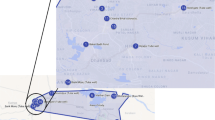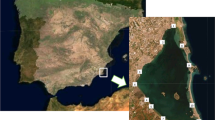Abstract
Isotopic compositions of B and Sr in rocks and sediments can be used as tracers for plant provincial sources. This study aims to test whether tea leaf origin can be discriminated using 10B/11B and Sr isotopic composition data, along with concentrations of major/trace elements, in tea specimens collected from major plantation gardens in Taiwan. The tea leaves were digested by microwave and analyzed by multi-collector inductively coupled plasma mass spectrometry (MC-ICPMS). The data showed significant variations in 87Sr/86Sr ratios (from 0.70482 to 0.71462), which reflect changes in soil, groundwater or irrigation conditions. The most radiogenic tea leaves were found at the Taitung garden and the least radiogenic ones were from the Hualien garden. The δ 11B was found to change appreciably (δ 11B = 0.38–23.73 ‰) which could be due to fertilizers. The maximum δ 11B was also observed in tea samples from the Hualien garden. Principal component analysis combining 87Sr/86Sr, δ 11B and major/trace elements results successfully discriminated different sources of major tea gardens in Taiwan, except the Hualien gardens, and this may be due to rather complicated local geological settings.



Similar content being viewed by others
References
Barth, S. (1993). Boron isotope variations in nature: A synthesis. Geologische Rundschau, 82, 640–651.
Bentahila, Y., Othman, D. B., & Luck, J. M. (2008). Strontium, lead and zinc isotopes in marine cores as tracers of sedimentary provenance: A case study around Taiwan orogen. Chemical Geology, 248, 62–82.
Bong, Y. S., Shin, W. J., Gautam, M. K., Jeong, Y. J., Lee, A. R., Jang, C. S., et al. (2012). Determining the geographical origin of Chinese cabbages using multielement composition and strontium isotope ratio analyses. Food Chemistry, 135, 2666–2674.
Chan, K. (2003). Some aspects of toxic contaminants in herbal medicines. Chemosphere, 52, 1361–1371.
Chao, H. C., You, C. F., Liu, H. C., & Chung, C. H. (2013). The origin and migration of mud volcano fluids in Taiwan: Evidence from hydrogen, oxygen, and strontium isotopic compositions. Geochimica et Cosmochimica Acta, 114, 29–51.
Chen, Z. M. (1984). The environmental pollutants in tea products. Chinese Journal of External Agriculture, 3, 1–10.
Chen, C. H., & Lee, T. (1990). A Nd–Sr isotopic study on river sediments of Taiwan. Proceedings of the Geological Society of China, 33(4), 339–350.
Cividini, D., Lemarchand, D., Chabaux, F., Boutin, R., & Pierret, M. C. (2010). From biological to lithological control of the B geochemical cycle in a forest watershed (Strengbach, Vosges). Geochimica et Cosmochimica Acta, 74, 3143–3163.
Crittenden, R., Andrew, G. A. S., LeFournour, M., Young, M. D., Middleton, H., & Stockmann, R. (2007). Determining the geographic origin of milk in Australasia using multi-element stable isotope ratio analysis. International Dairy Journal, 17, 421–428.
Dambiec, M., Polechońska, L., & Klink, A. (2013). Levels of essential and non-essential elements in black teas commercialized in Poland and their transfer to tea infusion. Journal of Food Composition and Analysis, 31, 62–66.
De Souza, G. F., Reynolds, B. C., Kiczka, M., & Bourdon, B. (2010). Evidence for mass dependent isotopic fractionation of strontium in a glaciated granitic watershed. Geochimica et Cosmochimica Acta, 74(9), 2596–2614.
Durante, C., Baschieri, C., Bertacchini, L., Cocchi, M., Sighinolfi, S., Silvestri, M., & Marchetti, A. (2013). Geographical traceability based on 87Sr/86Sr indicator: A first approach for PDO Lambrusco wines from Modena. Food Chemistry, 141, 2779–2787.
Fernández, P. L., Pablos, F., Martín, M. J., & González, A. G. (2002). Multi-element analysis of tea beverages by inductively coupled plasma atomic emission spectrometry. Food Chemistry, 76, 483–489.
Fung, K. F., Zhang, Z. Q., Wong, J. W. C., & Wong, M. H. (2003). Aluminium and fluoride concentrations of three tea varieties growing at Lantau Island, Hong Kong. Environmental Geochemistry and Health, 25, 219–232.
Gupta, U. C. (1979). Boron nutrition of crops. Advances in Agronomy, 31, 273–307.
Han, W., Zhao, F., Shi, Y., Ma, L., & Ruan, J. (2006). Scale and causes of lead contamination in Chinese tea. Environmental Pollution, 139, 125–132.
Hershey, J. P., Fernandez, M., Milne, P. J., & Millero, F. J. (1986). The ionization of boric acid in NaCl, Na–Ca–Cl, and Na–Mg–Cl solutions at 25°C. Geochimica et cosmochimica, 50, 143–148.
Horn, P., Hoelzl, S., Todt, W., & Matthies, D. (1998). Isotope abundance ratios of Sr in wine provenance determinations in a tree-root activity study and of Pb in a pollution study on tree-rings. Isotopes in Environmental and Health Studies, 34, 31–42.
Jin, C. W., Dua, S. T., Zhanga, K., & Lin, X. Y. (2008). Factors determining copper concentration in tea leaves produced at Yuyao County, China. Food and Chemical Toxicology, 46, 2054–2061.
Jin, C. W., He, Y. F., Zhang, K., Zhou, G. D., Shi, J. L., & Zheng, S. J. (2005). Lead contamination in tea leaves and non-edaphic factors affecting it. Chemosphere, 61, 726–732.
Kakihana, H., Kotaka, M., Satoh, S., Nomura, M., & Okamoto, M. (1977). Fundamental studies on ion exchange separation of boron isotopes. Bulletin of the Chemical Society of Japan, 50, 158–163.
Karak, T., & Bhagat, R. M. (2010). Trace elements in tea leaves, made tea and tea infusion: A review. Food Research International, 43, 2234–2252.
Kelly, S., Heaton, K., & Hoogewerff, J. (2005). Tracing the geographical origin of food: The application of multi-element and multi-isotope analysis. Trends in Food Science & Technology, 16, 555–567.
Komor, S. C. (1997). Boron contents and isotopic compositions of hog manure, selected fertilizers, and water in Minnesota. Journal of Environmental Quality, 26, 1212–1222.
Kumar, A., Nair, A. G. C., Reddy, A. V. R., & Garg, A. N. (2005). Availability of essential elements in Indian and US tea brands. Food Chemistry, 89, 441–448.
Lan, C. Y., Lee, T. P., Jahn, B. M., & Yui, T. F. (1995). Taiwan as a witness of repeated mantle inputs—Sr–Nd–O isotopic geochemistry of Taiwan granitoids and metapelites. Chemical Geology, 124, 287–303.
Liu, H. C., You, C. F., Chen, C. Y., Liu, Y. C., & Chung, M. T. (2014). Geographic determination of coffee beans using multi-element analysis and isotope ratios of boron and strontium. Food Chemistry, 100, 1456–1463.
Liu, H. C., You, C. F., Huang, K. F., & Chung, C. H. (2012a). Precise determination of triple Sr isotopes (87Sr and 88Sr) using MC-ICP-MS. Talanta, 88, 338–344.
Liu, Y. C., You, C. F., Huang, K. F., Wang, R. M., Chung, C. H., & Liu, H. C. (2012b). Boron sources and transport mechanisms in river waters collected from southwestern Taiwan: Isotopic evidence. Journal of Asian Earth Sciences, 58, 16–23.
Madhu, M., Sahoo, D. C., Sharda, V. N., & Sikka, A. K. (2011). Rainwater-use efficiency of tea (Camellia sinensis (L.)) under different conservation measures in the high hills of south India. Applied Geography, 31, 450–455.
Miller, J. C., & Miller, J. N. (1984). Statistic for analytical chemistry. New York: Wiley.
Nookabkaew, S., Rangkadilok, N., & Satayavivad, J. (2006). Determination of trace elements in herbal tea products and their infusions consumed in Thailand. Journal of Agricultural and Food Chemistry, 54, 6939–6944.
Oda, H., Kawasaki, A., & Hirata, T. (2001). Determination of the geographic origin of brown-rice with isotope ratios of 11B/10B and 87Sr/86Sr. Analytical Sciences, 17, i1627–i1630.
Rosner, M., Pritzkow, W., Vogl, J., & Voerkelius, S. (2011). Development and validation of a method to determine the boron isotopic composition of crop plants. Analytical Chemistry, 83(7), 2562–2568. doi:10.1021/ac102836h.
Ruan, J., Ma, L., & Shi, Y. (2006). Aluminium in tea plantations: Mobility in soils and plants, and the influence of nitrogen fertilization. Environmental Geochemistry and Health, 28, 519–528.
Ruan, J., & Wong, M. (2001). Accumulation of fluoride and aluminium related to different varieties of tea plant. Environmental Geochemistry and Health, 23, 53–63.
Rummel, S., Hoelzl, S., Horn, P., Rossmann, A., & Schlicht, C. (2010). The combination of stable isotope abundance ratios of H, C, N and S with 87Sr/86Sr for geographical origin assignment of orange juices. Food Chemistry, 118, 890–900.
Stewart, B. W., Capo, R. C., & Chadwick, O. A. (1998). Quantitative strontium isotope models for weathering, pedogenesis and biogeochemical cycling. Geoderma, 82, 173–195.
Street, R., Drábek, O., Száková, J., & Mládková, L. (2007). Total content and speciation of aluminium in tea leaves and tea infusions. Food Chemistry, 104, 1662–1669.
Techer, I., Lancelot, J., Descroix, F., & Guyot, B. (2011). About Sr isotopes in coffee ‘Bourbon Pointu’ of the Réunion Island. Food Chemistry, 126, 718–724. doi:10.1016/j.foodchem.2010.11.035.
Voerkelius, S., Lorenz, G. D., Rummel, S., Quétel, C. R., Heiss, G., Baxter, M., et al. (2010). Strontium isotopic signatures of natural mineral waters, the reference to a simple geological map and its potential for authentication of food. Food Chemistry, 118, 933–940.
Wieser, M. E., Iyer, S. S., Krouse, H. R., & Cantagallo, M. I. (2001). Variations in the boron isotope composition of Coffea arabica beans. Applied Geochemistry, 16, 317–322.
Wong, M. H., Zhang, Z. Q., Wong, J. W. C., & Lan, C. Y. (1998). Trace metal contents (Al, Cu and Zn) of tea: Tea and soil from two tea plantations, and tea products from different provinces of China. Environmental Geochemistry and Health, 20, 87–94.
Xiao, J., Xiao, Y. K., Jin, Z. D., He, M. Y., & Liu, C. Q. (2013). Boron isotope variations and its geochemical application in nature. Australian Journal of Earth Sciences, 60, 431–447.
You, C.-F. (2004). Thermal ionization mass spectrometry techniques on boron isotopic analysis: A review. In P. de Groot (Ed.), Handbook of stable isotope analytical techniques, Chap. 7 (Vol. 1, pp. 142–152). Amsterdam: Elsevier. ISBN 044451114-8.
You, C. F., Spivack, A. J., Gieskes, J. M., Rosenbauer, R., & Bischoff, J. M. (1995). Experimental study of boron geochemistry: Implication for fluid processes in convergent margin. Geochimica et Cosmochimica Acta, 59, 2435–2442.
Acknowledgments
We thank Drs. Y.J. Tu for analytical assistance on ICP-OES and J.C. Wu (Director of TRES) for sharing tea leaf specimens. This study was financial supported by MOST and MOE, Taiwan, to Y.C.F.
Author information
Authors and Affiliations
Corresponding author
Rights and permissions
About this article
Cite this article
Chang, CT., You, CF., Aggarwal, S.K. et al. Boron and strontium isotope ratios and major/trace elements concentrations in tea leaves at four major tea growing gardens in Taiwan. Environ Geochem Health 38, 737–748 (2016). https://doi.org/10.1007/s10653-015-9757-1
Received:
Accepted:
Published:
Issue Date:
DOI: https://doi.org/10.1007/s10653-015-9757-1




